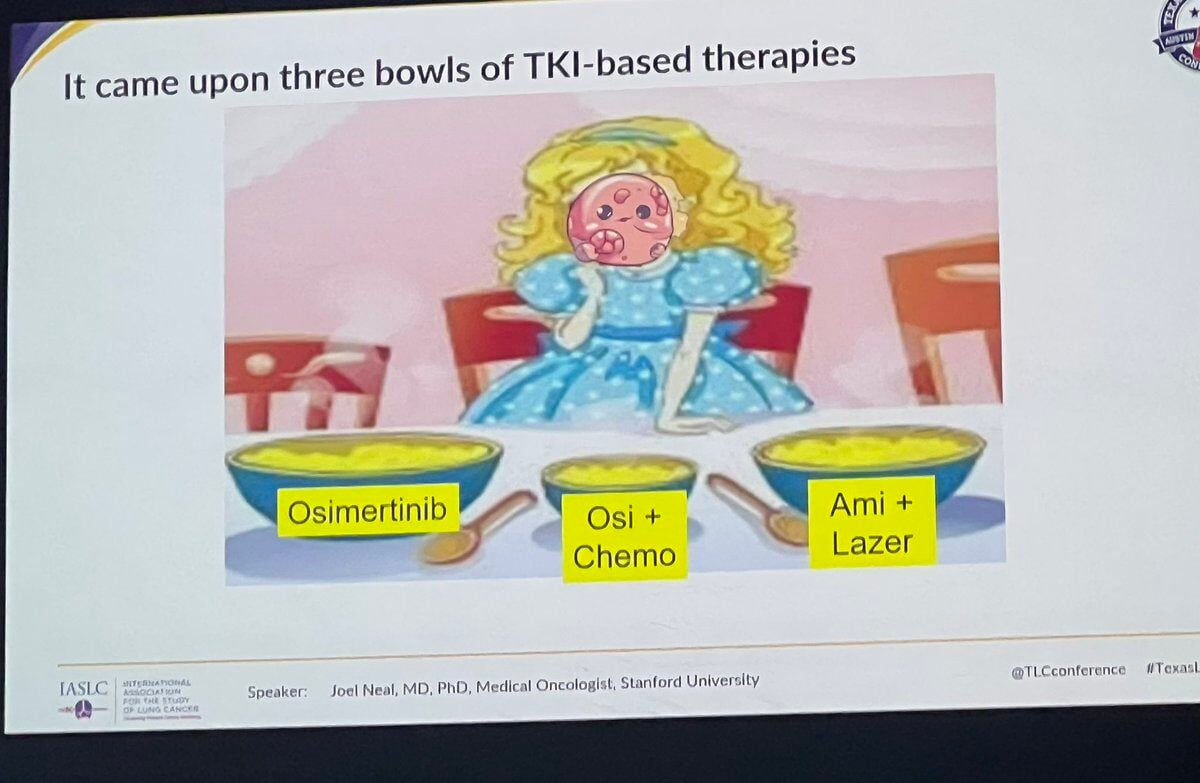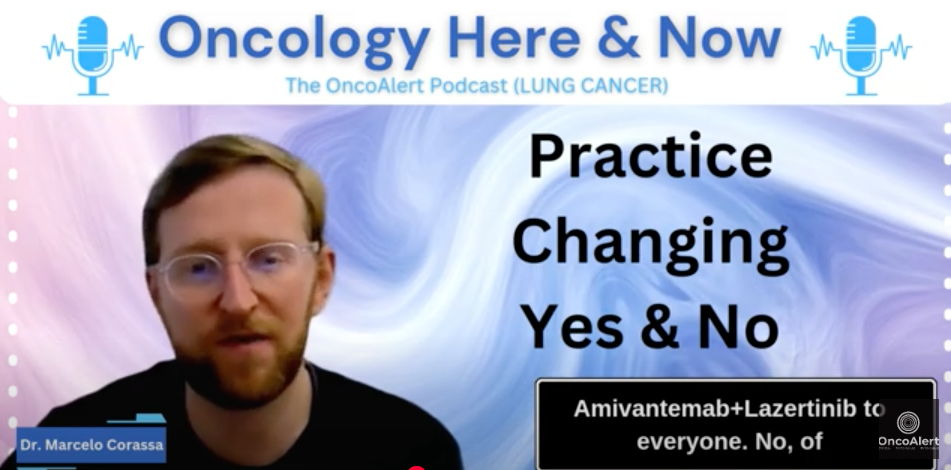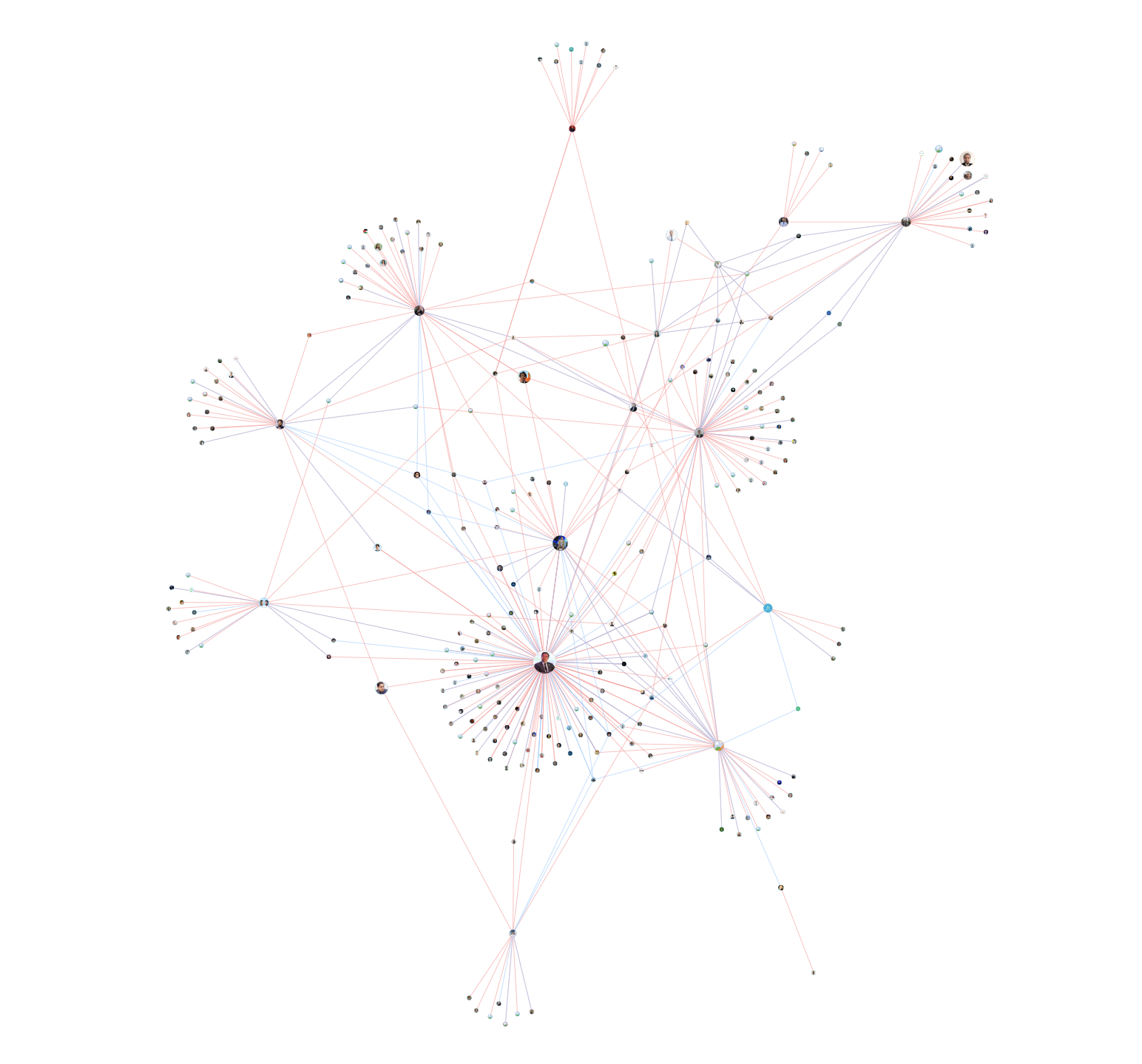5 min read
Lung Cancer KOLs Use Memes to Communicate EGFRmut Treatments
Brian Shields
:
Apr 15, 2025 6:40:12 AM

The Role of Memes in Communicating Lung Cancer Treatment Challenges: A Focus on EGFR Mutation Therapy
In the realm of healthcare communication, memes have emerged as an innovative tool by Key Opinion Leaders, especially when conveying complex treatment decisions to patients and the public. Lung cancer experts have creatively utilized memes to discuss the intricacies surrounding the choice of therapy for EGFR-mutated non-small cell lung cancer (NSCLC).
In this blog, we explore the influence of memes, analyze the latest survival data from the MARIPOSA study presented at ELCC25, and examine various treatment options, highlighting some popular memes employed by medical professionals.
Understanding MARIPOSA Survival Data: Insights from ELCC25 and #TexasLung25
At the recent European Lung Cancer Congress (ELCC25), new survival data from the MARIPOSA study was presented, providing valuable insights into the efficacy of novel treatment regimens for EGFR-mutated NSCLC. Notably, the MARIPOSA trial showed a significant overall survival (OS) benefit for the combination of amivantamab and lazertinib over osimertinib. While demonstrating an OS hazard ratio of 0.75, the study highlighted the an extended OS benefit of at least a year with this combination. This data forms the basis for discussions among oncologists and patients regarding optimal treatment strategies. KOLs at ELCC25 and the recent TexasLung25 meeting shared creative memes to demonstrate their challenges when selecting the best treatments for these patients.
Exploring Treatment Choices: Osimertinib Monotherapy vs. Combination Therapies
EGFR-mutated NSCLC therapy choices vary significantly, adding layers of complexity to treatment decisions:
-
Osimertinib Monotherapy: Often considered the standard first-line treatment, it provides a targeted approach with a well-understood efficacy and safety profile.
-
Osimertinib plus Chemotherapy: Combining targeted therapy with chemotherapy may offer enhanced efficacy such as increased response rate (ORR) and longer progression free survival (PFS) but also comes with increased side effects, making it a more intense choice. Patients will experience the adverse events of the added chemotherapy, and the "time toxicity" of visits for infusions. This combination has yet to report an overall survival benefit (OS) versus single agent osimertinib, but that data readout is upcoming this year. KOLs have discussed specific patient groups that may benefit the most from the addition of chemotherapy to osimertinib.
Personally, I would discuss but in absence, at least, of an OS trend I wouldn't recommend chemo-osi for all pts, maybe brain mets or poor prognostic groups. There is a long history in oncology of adding two effective treatments together being additive not necessarily synergistic
— Patrick Forde (@FordePatrick) September 11, 2023
-
MARIPOSA Regimen (Amivantamab + Lazertinib): This novel regimen, gaining attention for its significant OS benefit, adds another dimension to treatment options. The COCOON trial provides insights into managing toxicities associated with this regimen. The recent OS benefit has been a gamechanger in the choice of sequencing agents for the treatment of EGFRmut Recent data from the PALOMA-3 trial demonstrated the benefits of subcutaneous use of this regimen, pending US FDA approval. In PALOMA-3, patients experienced 5x lower infusion related reactions and a significant decrease in Venous Thromboembolism Events. Also, administration time decreased from 2-4 hours per infusion to. 5-10 minutes per injection. The European Union recently approved this subcutaneous formulation based on the PALOMA-3 clinical trial.
Osimertinib BEATEN!! MARIPOSA (Ami + Lazer) shows significant OS (HR 0.75, p<0.005, 3yr 60% vs 51%) and landmark 3-yr icPFS improvement (36% vs 18%)—first combo to show OS superiority over SoC, extending OS beyond 3 years in 1L EGFRm NSCLC. #ESMOAmbassadors #ELCC25 @myESMO pic.twitter.com/cstBfz89iS
— Noemi Reguart (@NReguart) March 26, 2025
Comparative Trials: FLAURA2 vs. MARIPOSA
Understanding the findings from ELCC25 requires examining the comparative trials that influence treatment decisions. Oncologists not only need to consider the risk/benefit of each regimen in the 1L NSCLC EGFRmut setting, but they also must consider the entire sequence of care for these patients. At ELCC25, key opinion leaders discussed the comparative clinical trial data and the choices available throughout the sequence.
Treatment sequence in EGFR mut+ is dependent on first line decision #ELCC25 @myESMO @OncoAlert @OncoReporte pic.twitter.com/xQPtGcAMua
— Bartomeu Massuti (@bmassutis) March 28, 2025
What is the best regimen post 1 line treatment in egfr mutated advanced NSCLC ? Nice slide to show second line options as per what is used in first line. @myESMO #ELCC2025 pic.twitter.com/4ro3uX8l2x
— Dr Amol Akhade (@SuyogCancer) March 28, 2025
FLAURA Trial: In 2017, this trial identified osimertinib as the leading first-line therapy for advanced EGFR-mutated NSCLC. It demonstrated a significant benefit in progression-free survival (PFS), with a median duration of 18.9 months compared to 10.2 months for first-generation TKIs, resulting in an 8.7-month improvement (hazard ratio [HR] 0.46; 95% CI, 0.37–0.57; p<0.001).
Overall Survival (OS): The final analysis showed that osimertinib increased median OS to 38.6 months, compared to 31.8 months for first-generation TKIs (HR 0.80; 95% CI, 0.64–1.00; p=0.046), offering a 6.8-month survival advantage.
FLAURA2 Trial: This study investigates whether adding chemotherapy to osimertinib enhances outcomes without significantly impacting quality of life.
MARIPOSA Trial: This trial provides a direct comparison between the combination of amivantamab and lazertinib vs osimertinib, revealing at least a one-year OS benefit while also addressing the challenges of managing treatment-related toxicities.
The moving landscape for EGFR mut+ Lung Cancer at #ELCC2025 @myESMO @OncoAlert pic.twitter.com/tkLVQcFAKd
— Bartomeu Massuti (@bmassutis) March 27, 2025
Memes as a Medium: Simplifying Complex Treatment Choices
Oncologists have cleverly employed memes to bridge the gap in understanding the current challenges in choosing the best treatments for 1L EGFRmut in the context of these various considerations for patients
-
Goldilocks Porridge Meme: Highlighting the quest for the "just right" treatment balance, this meme is instrumental in explaining the delicate balance required in choosing the right therapy for EGFR-mutated NSCLC. At the TexasLung25 meeting of Lung Cancer KOLs, Dr.Jennifer Marks, Dana-Farber Cancer Center, shared this meme from the presenters, regarding the need for the ultimate triple arm clinical trial.
Y'all I'm 💀💀💀.
— Jennifer A. Marks, MD (@jennifermarksmd) April 12, 2025
Lung & Order — The trial of the century: Frontline treatment for -#EGFR positive mNSCLC#TexasLung25 @TLCconference@EgfrUk @EGFRResisters #lcsm @JoelNealMD pic.twitter.com/fV9pBHWU7L -
Choices Button Meme: Demonstrates the sometimes overwhelming and difficult decisions patients and doctors face when selecting the appropriate treatment among multiple effective options, Dr. Eric Singhi, MD Anderson Cancer Center, shared this meme following the press release of the MARIPOSA OS data.
‼️#MARIPOSA study update: Combination therapy shows over ONE-YEAR mOS improvement compared to osimertinib alone.
— Eric K. Singhi, MD (@lungoncdoc) January 7, 2025
Key data to discuss with patients in clinic—but does this simplify first-line treatment decisions? @OncoAlert @OncBrothers @EGFRResisters #lcsm https://t.co/bgjvbmgXAL pic.twitter.com/PlfAer0eBr -
Huge Backpack Meme (COCOON Trial): Represents the substantial support and management required for patients undergoing intensive regimens like MARIPOSA, as highlighted in the COCOON trial. This visual metaphor underscores the need for comprehensive support systems alongside complex treatment plans. Dr. Balasz Halmos, Montefiore-Einstein, shared this meme in an active tweet discussion with Dr. Eric Singhi, and Jill Feldman, an active patient advocate.
Indeed- as the MARIPOSA regimen will find expanded use with the exciting OS data- side effect management will be key! Get that backpack ready! pic.twitter.com/CvZvP8jgDD
— Balazs Halmos (@BalazsHalmosMD) March 27, 2025
ICYMI: COCOON Trial (and SKIPPirr) Overview for Management of amivantanab skin toxicities
Beta blockers? For these cutaneous or scalp lesions for amivantamab? COCOON nor SKIPPirr has propranolol as part the regimen. Have you used this and had good response? pic.twitter.com/1ZcQUdlVFL
— Oncology Brothers (@OncBrothers) March 20, 2025
Importance of Memes in Cancer Treatment Communication
Utilizing memes in healthcare communication significantly aids in demystifying complex medical concepts, making them accessible and relatable. For oncologists, this creative tool offers a means to engage with peers and patients on a more personal level, ensuring they understand their treatment options and the rationale behind each choice. Memes also facilitate a collaborative decision-making process, empowering patients through informed consent.
In conclusion, memes serve as a vital educational resource in the landscape of lung cancer treatment, particularly for EGFR mutations. They not only humorously depict the challenges and considerations in therapy selection but also play an essential role in enhancing patient comprehension and engagement, ensuring that communication in oncology continues to evolve with the needs of patients and medical professionals alike. With ASCO just around the corner, it will be interesting to see how KOLs continue to use memes to further explain the evolving treatment landscapes.

MARIPOSA Trial Investigator Shares the Inside Scoop
In a powerful video discussion with Dr. Biagio Ricciuti, Dana-Farber Cancer Center, Dr. Marcelo Corassa shared an impressive discussion of the...


